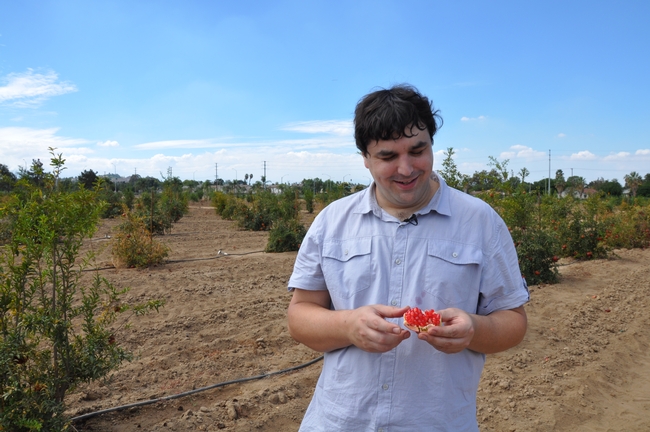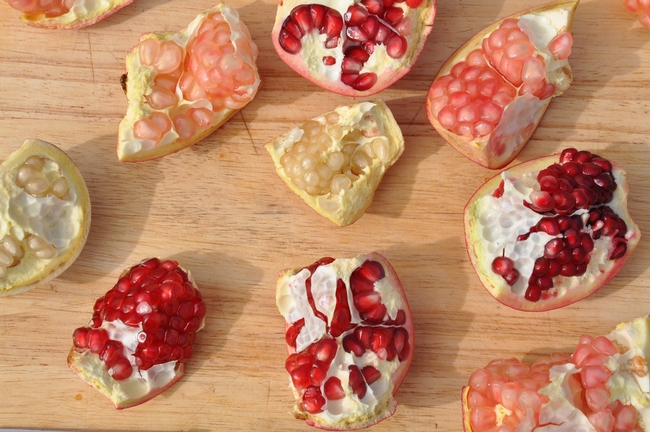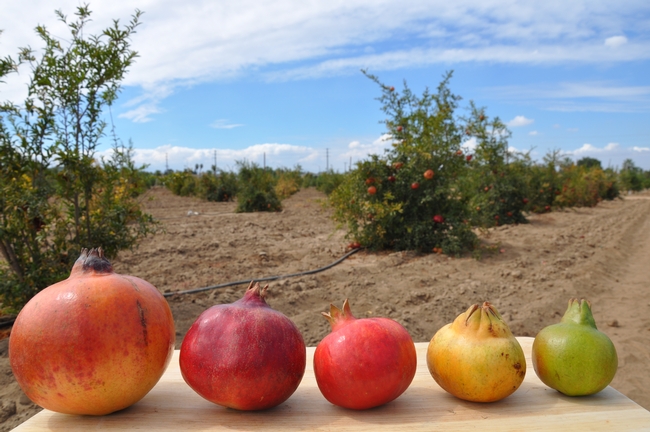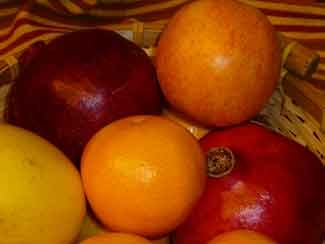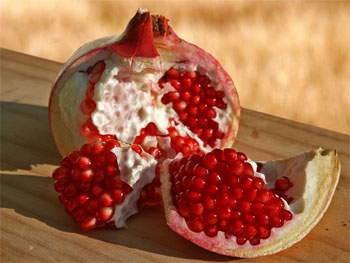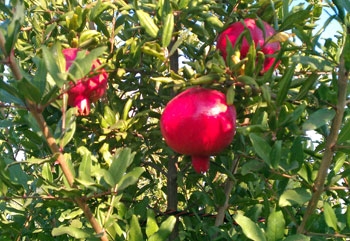Posts Tagged: pomegranate
Expanding pomegranate production
John Chater remembers the day vividly. He was about two years old. His grandfather gave him a dark, purplish pomegranate. Happily, he opened it and starting eating.
He quickly realized his mistake. He was wearing his new light brown suede shoes. The pomegranate juice quickly found the shoes, leaving a permanent scar.
“That was my first experience, that I remember, with pomegranates, and it involved getting in trouble,” Chater said. “Because it was so delicious, I didn't realize it would stain.”
More than 30 years later, Chater is a Ph.D. student at the University of California, Riverside, with a focus on pomegranate research and a 2016 University of California Global Food Initiative student fellow. He is building on the work of his grandfather, S. John Chater, who was a maintenance worker at hospital but developed a cult following among rare fruit growers in California for developing new varieties of pomegranates.
The younger Chater, working with varieties selected from the National Clonal Germplasm Repository in Winters, including several developed by his grandfather (who died in 2002), is working to better understand the commercial potential of these varieties.
Currently, 90 to 95 percent of pomegranates are one variety: Wonderful, Chater said. (In addition, California grows more than 95 percent of pomegranates in the United States, he said.)
Working under Don Merhaut, UC Cooperative Extension specialist for ornamental and floriculture crops at UC Riverside, Chater has set up pomegranate variety trials in Riverside and Camarillo.
They have planted 12 pomegranate varieties, 15 trees per variety, to evaluate their establishment, precocity (flowering and fruiting), usefulness to growers and desirability to consumers.
Of the 12 varieties, 10 are edible (Parfianka, Desertnyi, Wonderful, Ambrosia, Eversweet, Haku Botan, Green Globe, Golden Globe, Phoenicia and Lofani) and two are ornamental (Ki Zakuro and Nochi Shibori). The ornamental varieties, whose flowers look like carnations, could be of interest to the floriculture industry, Chater said.
The researchers want consumers to be able to go to supermarket, and, like apples and citrus, be able to buy different varieties of pomegranates that vary in sweetness, seed hardness and color. (The varieties Chater is studying range in color from green to yellow to pink to orange to red to nearly purple.)
Chater set up the trials in Riverside and Camarillo to evaluate the difference between the cooler coastal climate and the warmer inland climate.
The prevailing thought is that more acidic varieties do better in inland conditions because the high summer temperatures reduce the acidity before the fruit is picked in the fall.
For example, a variety such as Wonderful, which is high in acidity, is grown commercially in the Central Valley. But, Eversweet, which has a lower acidity, does well on the coast.
Related to color, some researchers believe that pomegranates color up because of cool night time temperatures. Therefore, trees planted on the coast tend to color up faster.
All that said, it is believed no one has done a comprehensive study, such as the experimentally-designed one Chater has set up, in the United States. It will allow him to study the interplay of variables including size, color, sweetness, acidity, antioxidant activities and seed hardness in different climate conditions.
This story en español.
View a video featuring John Chater and his pomegranate research below:
Pomegranates in the fruit bowl - what now?
Each fall I am delighted by the vibrant color of the pomegranates on display in the produce section of the market. I succumbed to their ancient beauty a few days ago, and purchased two. They added their glistening jewel tones to the fall leaves and dried corn cobs that graced our Thanksgiving table. “Help yourself,” I told our guests. “Please enjoy eating them, that’s what they’re for.” But no one took advantage of the offer, and the lovely pomegranates languished in our post-holiday fruit basket. That got me to wondering what fun things I could do with them before they were neglected too long and ended up in our green barrel as compost.
Mentioned in ancient literature, the name pomegranate is derived from the French words “pomme garnete” or seeded apple. Pomegranates grow on small trees or bushes and were introduced to California agriculture nearly 250 years ago. California acreage planted with pomegranates has doubled in the past five years, with most of the harvested fruit going to make juice concentrates, primarily utilized for their purported antioxidant and other health benefits.
I was surprised by the numerous recipes utilizing the tart-sweet arils from pomegranates, along with handy tips about the best way to part them from the pomegranate’s husk and membranes. Following is a recipe that allowed us a few arils to snack on, and used the rest of the pomegranates in a delicious and delightful new way to enjoy salmon.
Salmon with Pomegranate and Lentil Couscous (from the Pomegranate Council’s website)
Couscous:
1 c. small green Puy lentils
2 c. cold water
2 Tb. Olive oil
1 large onion, minced
1 apple, peeled, cored, and cubed
1 2/3 c. (10 oz.) quick-cooking couscous
2 c. boiling water
1 large pomegranate, seeded
1 Tb. coarsely chopped fresh lemon thyme
Kosher salt and freshly ground black pepper
Salmon:
6, 6-oz. salmon fillets
Olive oil for frying
Kosher salt and freshly ground black pepper
Fresh thyme sprigs, for garnish
Pomegranate arils, for garnish
Lentil & couscous preparation: Pick through lentils and discard any debris, then rinse well with cold water. In large saucepan, combine water and lentils, and bring to a boil over high heat. Reduce heat to medium and boil gently until tender, about 20-30 minutes. Drain, set aside. In medium frying pan heat the oil over medium heat. Add onions and cook, stirring occasionally, until golden brown. Add the apple and cook until it begins to soften. Sprinkle the pomegranate arils and couscous over the onion-apple mixture, then carefully add the boiling water. Remove from the heat, cover, and let stand while you prepare the salmon. Add herbs, salt and pepper to taste.
Salmon preparation: Heat a large non-stick sauté pan over medium heat. Brush salmon fillets with olive oil and season generously with salt and pepper. Place skin side down in the hot pan. Cook, without disturbing, until the skin is golden brown, about 4-5 minutes. Turn the fillets over and continue cooking just until done, 2-3 minutes. Remove from heat and serve over pomegranate couscous. On the serving tray, layer lentils and couscous, then top with salmon. Garnish with additional pomegranate arils and thyme.
The colorful, healthful pomegranate is a good food and lovely landscape plant
A jewel-toned garnish for California cuisine, antioxidant-rich elixir of good health, drought-resistant tree ideal for desert-like regions in California, the pomegranate has inner beauty and outward resiliency driving its growing popularity.
Pomegranates have been cultivated since ancient times, and are referred to poetically in texts ranging from the Bible to Shakespeare’s Romeo and Juliet. They are unusual among California fruit. Tough, leathery skin protects bright red, tart-sweet juice sacs, called arils, which are separated in groups by white spongy tissue. Inside each sac is an edible seed which contains fiber and unsaturated fat. The red pulp is a good source of potassium and vitamin C.
More a large shrub than a tree, with multiple trunks reaching a height of 15 to 20 feet, pomegranates are adapted to regions with cool winters and hot summers. Beautiful shiny foliage and a long flowering season make them attractive additions to coastal, inland valley and desert landscapes. Pomegranates tolerate a wide range of soil types, but prefer deep, well-drained loams. The best time to plant is in late winter or early spring – just before they leaf out.
Data about the scope of California commercial pomegranate production is hard to find. USDA stopped collecting pomegranate data in 1989 and CDFA groups pomegranates with kumquats, loquats, persimmons, prickly pears and other unusual fruit. UC Cooperative Extension farm advisor Maxwell Norton said county pesticide registration data indicate that five Central Valley counties – Kern, Fresno, Madera, Kings and Tulare – have about 35,000 acres planted to pomegranate. About 500 acres are planted in other counties combined. Kern County has the highest production with about 17,000 acres producing fruit valued at $115 million per year.
UC Cooperative Extension farm advisor Paul Vossen suggests the following standard varieties for backyard plantings:
- Ambrosia – Huge fruit, pale pink skin, similar to Wonderful
- Eversweet – Very sweet. Red skin, clear juice. Good for coastal areas
- Granada – Deep crimson fruit color. Matures early, but needs heat
- Ruby Red – Matures late, but not as sweet or colorful as Wonderful.
- Wonderful – Large, deep red fruit, large, juice red kernels. Small seeds.
For eating or juicing, select pomegranates at grocery stores by weight, not color. The heavier the pomegranate, the more juice inside. Some consumers are deterred from purchasing and eating the raw fruit because they believe it’s difficult to prepare. UC Master Food Preserver Geri Scalzi gives five simple steps that make eating fresh pomegranate easy:
- Cut off the top half an inch below the crown. Four to six sections of pomegranate arils divided by white membrane will be visible.
- Score the leathery skin with a sharp knife along each section.
- Break the pomegranate apart along the score lines. This can be done under water to prevent squirting pomegranate juice, which tends to stain clothing.
- Loosen arils and membranes and drop them into water. The arils will sink, the membranes will float. Skim off the membranes with a slotted spoon.
- Pour the arils and remaining liquid through a strainer.
The pulpy seed sacs are then ready to be eaten plain, tossed in salads, stirred into yogurt or sprinkled over cereal.
For more information on pomegranate production, attend a public meeting at the UC Kearney Agricultural Research and Extension Center, 9240 S. Riverbend Ave., Parlier, from 10 a.m to 1 p.m. Tuesday, Nov. 29. The following topics will be covered:
- Insect pest update, integrated pest management entomologist Walt Bentley
- Black heart disorder and tree decline issues, UC Davis plant pathologist Themis Michailides
- Interesting selections in the USDA germplasm collection, USDA national clonal germplasm representative Jeff Moersfelder
- Irrigation, fertigation & nitrogen use efficiency with drip irrigation, Claude J. Phené, USDA-ARS
- Summary of acreage trends, Merced County farm advisor Maxwell Norton
RSVP to Yolanda Murillo at ymurillo@ucdavis.edu or (559) 600-7285. The $10 registration fee may be paid at the door with cash or check. More information.
How authentic is your pomegranate juice?
You pick up a bottle of pomegranate juice because you’ve learned that, although it costs more than most juices, it is replete with antioxidants that bring health benefits. But wait: Is the juice you’ve purchased really pomegranate juice? Or is the product label you have carefully read promising more than it delivers?
UC Riverside chemistry professor Cynthia Larive is determined to find out. She is playing detective by applying chemical tests to juice products sold as pomegranate juice or pomegranate juice blends in order to authenticate their contents.
“We are measuring levels of unique compounds in pomegranate juice and are able to use this ‘molecular fingerprint’ to discriminate against adulterated juice products,” says Larive, whose research on pomegranate juice is being funded by a nearly $50,000 one-year grant from Pom Wonderful, a company that grows and markets pomegranates and pomegranate-based products.
In the lab, Larive and her graduate student Daniel Orr are measuring levels of biochemicals in juices, such as amino acids, organic acids, sugars, pomegranate pigment compounds and health-producing antioxidant molecules that are unique to pomegranate juice.
“We have received a collection of pomegranate samples from around the world, as well as commercial juices such as beet, grape, apple and pear – to name just a few,” Larive says. “We’re looking at whether or not our molecular fingerprint method can be used to identify products claiming to contain pomegranate juice when they don’t, and products claiming to be pomegranate juice when they are not.”
Larive plans to publish her results soon in a peer-reviewed journal. For the complete news release about the research, see the UC Riverside media website.

Cynthia Larive and Daniel Orr examine pomegranate juice.


